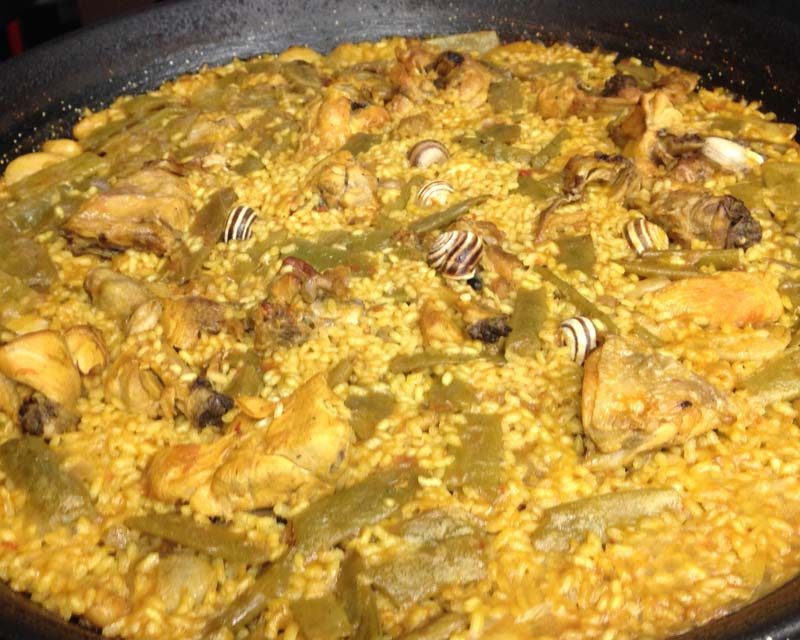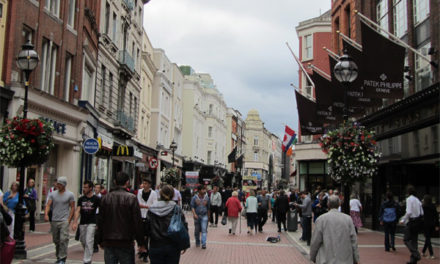Paella — it’s the ultimate one-pan meal. And to really enjoy it, travel to Valencia, Spain and learn how to make paella Valenciana. There, the men of the house make paella on Sundays for their families, significant others and friends. It’s very social, and the experience usually includes beer, wine, salad, your paella, a dessert and more wine. Who wouldn’t want to do that? This is the way to barbecue and pass several hours.
And that’s what I did on a recent visit to Spain’s third largest city — I ate paella practically every day, and I learned how to make it. First, at the Escuela de Arroces y Paella Valenciana (the School of Paella in Valencia) and then at Barraca de Toni Montoliu, a country farmhouse with its own rustic restaurant (great for special events for groups up to 60) located in the Valencia’s countryside.
You need: rabbit (with bones and in pieces), chicken (also with bones and in pieces, broad green beans, garrofon (a Spanish white bean that’s very similar to a lima bean), a ripe tomato, Bomba rice (Spanish), extra virgin olive oil, paprika (smoked if you’re cooking indoors; sweet if you’re cooking over firewood), saffron, sprigs of rosemary and salt. Here’s how to make paella:
Shop the Market for Paella Ingredients
When in Valencia, the School of Paella in Valencia will take you to the Central Market, one of Europe’s oldest and most impressive public markets. They make it easy there because all you need to do is tell each vendor the number of people who will be having paella and they portion it out exactly. But back at home, that expertise isn’t as readily available, but you can buy fresh ingredients and portion it for yourself.
Cooking Your Paella
The first thing to do is prep the various ingredients. For the meat, that means cooking them with the bones. As for the vegetables, you should broad break the broad green beans into about one inch strips and the inside of the tomatoe(s) should be greater (don’t keep the skin).
At the cooking school which has an impressive indoor kitchen, these were prepped for us. At Toni Montoliu’s baracca, he cooks the paella outdoors. Toni involves guests in some of the cooking activities, so I stepped in to grill the chicken over orange tree firewood. But before doing anything at both places, my efforts began by first enjoying a beer (Turia is the local beer named after the river that passes through Valencia).
Paella must be cooked in a paella pan. It’s a sturdy steel pan with dimples in it, handles on two sides and a slight slope toward the middle that’s not easily noticeable. Paella pans are cost effective to buy when you’re in Valencia and elsewhere in Spain, so remember to take one back (asI did). You can find examples on paella pans from La Tienda.
Now you’re ready to cook:
- Heat the pan on a high flame and pour olive oil to the middle of the paella pan. Then, place the chicken and rabbit into the middle of the paella pan. “Sauté almost to the point at which the meat would begin to get a little crisped, but without arriving to that point since the meat should remain constantly in the paella pan the rest of the process, and therefore will continue to cook,” explains Máximo Caletrío, promotion manager for Turismo Valencia. You can now move the pieces to the side o the pan.
- Turn the heat to medium and add the beans to the middle. After that has cooked for a little bit (just a couple minutes). Add a small amount of paprika (smoked if you’re doing it in your kitchen; sweet if you’re cooking over wood). Move the beans to the side of the pan. Now drop in the grated tomatoes in the middle. It only takes a few minutes for the tomatoes to cook. Then add a pinch of the saffron threads.
- Add water so that it fills the pan nearly to the top. Drop in your rosemary sprig and let it boil for 10 to 15 minutes. Then, take out the rosemary sprig, add more water to return the level back toward the top of the pan. Stir and taste. This is a time for a quick taste test of the broth itself (only take from the bubbles to avoid the oils). Decide if you’ll need to add more salt.
- Add the rice to the middle and stir everything in the pan. The ratio of water to rice is roughly 4:1. “Once the rice is added and the stock boils again, you can no longer add any more water because the boil will be broken,” Caletrío explains. If it is stirred, the rice will become creamy like a risotto (and that’s not what you want). It will take about 20 minutes to fully absorb.
- After the liquid is fully absorbed (about 20 minutes), turn off the heat and let the paella rest. “By letting it rest, the rice finishes cooking by itself without the danger of burning on the bottom,” Caletrío adds. Nevertheless, it should still have a golden, toasty pieces of rice on the bottom. That’s what’s called “socarrat” and it’s prized!
Time to Eat Paella
By now you should have enjoyed a range of fragrances and a taste test. The next thing you’ll want to do is take in the paella with your eyes. When serving paella, make sure you mix up the paella as you take it out, making sure you get a little of the small bits from the bottom of the pan. It’s helpful to use a wooden spatula. It is also typically served with a salad.
Paella is traditionally placed in the center of the table, eaten directly from the pan using a wooden spoon and everyone shares in it.
Enjoy paella with your favorite choice of a drink. I personally like to start with a white wine and then switch to a red wine (and maybe even slip in a dessert wine). After the dessert course, Spaniards enjoy coffee or tea.
Paella Valenciana has been served for hundreds of years. Because I was at a cooking school, that was already prepped for us. But at home, it’s different. Regardless, once your ingredients are ready, it’s best to first relax with something to drink (and it seems that beer is like water in Spain). Then, it’s off to the kitchen (or your outdoor grill). You’ll also want to feel like a cook, and that means you need a chef’s hat and apron. And the cooking school gives you both.
Now that you know how to make paella Valenciana — the authentic way, you can enjoy it even more at home.
But if you substitute ingredients, know it’s just another rice dish that has been cooked in a paella pan.





